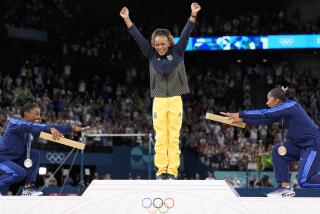The big game is in Olympics merchandising
- Share via
THE POP culture petri dish of the Olympic Games has made must-haves out of David Hockney posters (Munich, 1972), plush baby snow owls (Nagano, 1998), blue berets (Salt Lake City, 2002), even wedge haircuts (Innsbruck, 1976). And with the 2008 Summer Games gearing up to be the most merchandise-heavy Olympics in history, there are more candidates for fad stardom than ever before.
There will be a record 6,000-plus licensed items, including pins, apparel, posters, luggage and stuffed mascots (there’s an all-time high of five) made by 67 different companies and sold at 310 different places around Beijing. But what will resonate beyond the register and remain with us long after the last race is run and the Olympic flame has moved on is no sure bet. Will it be the first-ever collectible Olympic bank notes, the replica torches or a Ralph Lauren Team USA bucket hat that opens the hearts and wallets of Olympic fans and collectors? Or will it not be a product at all but a memorable soul patch, nail color or some other peri-Olympic style flourish?
Mascots are always popular, and of this year’s quintet-- a fish, a panda, a Tibetan antelope, a swallow and an anthropomorphized flame that looks like a cartoon brush fire -- the black-and-white panda named Jingjing is already outselling its compatriots.
“Mascots resonate if they’re tied to something in the host country that is identifiable around the world,” said Bill Korbus, the U.S. Olympic Committee’s associate director of merchandise, licensing and retail, who cited the panda as exactly the kind of mascot with broad appeal, compared with, say, the abstract figures from the 2004 Athens Games. “Those looked kind of like Gumby and Pokey.”
Currently, the most sought-after mascots on the resale market are the foursome of Furby-esque “snowlets” from the 1998 Nagano Games, not necessarily because they were cute and fuzzy, but because they sold out three days into the Games. “I was shocked that they were already collector’s items,” said David Wallechinsky, who has written several books on the Olympics and attended a dozen Games. “Usually you have to wade through them at the airport on the way home.”
But nothing in Olympic history has resonated at retail like the berets that Team USA wore in the opening ceremonies of the Salt Lake City Games in 2002. Despite the beret’s distinctively non-American vibe (only a Viking helmet would be more foreign), the maker, Roots Canada, sold more than a million of the blue fleece hats, and at one point during the Games had to ramp up production and charter a flight to deliver more to Salt Lake. “ Matt Lauer and Katie Couric wore them on the ‘Today’ show before the Games,” the USOC’s Korbus said. “And that was a huge factor.”
Polo Ralph Lauren will be dressing Team USA at Beijing’s opening ceremony and in the athletes’ village. The collection of patriotic staples such as red-, white- and blue-trimmed polos, cable-knit sweater vests, cargo shorts and bucket hats comes off as “Chariots of Fire” meets “The Preppy Handbook.” They are certainly more wearable than the berets (which now sell for $1.99 on EBay). Still, there isn’t much here that screams “buy me.” But the opening ceremony outfits are being guarded like a state secret, so Lauren, major domo of Americana, may yet have something memorable up his cotton piqué sleeve.
Many of the most stylish Olympic items -- remember the golden spikes that propelled runner Michael Johnson to victory in the 200-meter and 400-meter finals in Atlanta? -- are tailored to individual athletes, and never trickle down to retail. But this year, the Nike Hyperdunk sneakers that Kobe Bryant and some of his U.S. basketball teammates will be wearing have been burning up the sneakerhead blogs since they were unveiled in April. A $110 consumer version of the Hyperdunk went on sale Saturday.
More to Read
Go beyond the scoreboard
Get the latest on L.A.'s teams in the daily Sports Report newsletter.
You may occasionally receive promotional content from the Los Angeles Times.











